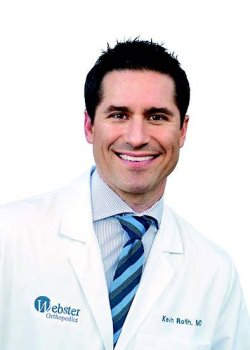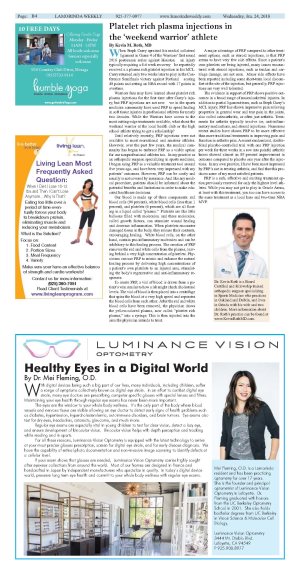| | Published January 24th, 2018
| Platelet rich plasma injections in the 'weekend warrior' athlete
| | | By Kevin M. Roth, MD |  | | Dr. Kevin Roth is a Board Certified and fellowship trained orthopedic surgeon specializing in Sports Medicine who practices in Oakland and Dublin, and lives in Orinda with his wife and two children. More information about Dr. Roth's practice can be found at www.KevinRothMD.com. |
When Steph Curry sprained his medial collateral ligament in Game 4 of the Warriors' first round 2016 postseason series against Houston - an injury typically requiring a 4-6 week recovery - he reportedly received a a plasma rich platelet injection in his MCL. Curry returned only two weeks later to play in the Conference Semifinals victory against Portland - scoring 40 points and setting an NBA record with 17 points in overtime.
 Warriors fans may have learned about platelet rich plasma injections for the first time after Curry's injury, but PRP injections are not new - we in the sports medicine community have used PRP to speed healing in soft tissue injuries in professional athletes for nearly two decades. While the Warriors have access to the most cutting-edge treatments available, what about the weekend warrior at the local health club or the high school athlete trying to get a scholarship?
Warriors fans may have learned about platelet rich plasma injections for the first time after Curry's injury, but PRP injections are not new - we in the sports medicine community have used PRP to speed healing in soft tissue injuries in professional athletes for nearly two decades. While the Warriors have access to the most cutting-edge treatments available, what about the weekend warrior at the local health club or the high school athlete trying to get a scholarship?
 Until relatively recently, PRP injections were not available to most recreational and amateur athletes. However, over the past few years, the medical community has begun to embrace PRP as a viable option for our nonprofessional athletes too. In my practice as an orthopedic surgeon specializing in sports medicine, I began using PRP as a valuable treatment tool around five years ago, and have been very impressed with my patients' outcomes. However, PRP can be costly and usually is not covered by insurance. And like any medical procedure, patients should be informed about the potential benefits and limitations in order to make educated healthcare decisions.
Until relatively recently, PRP injections were not available to most recreational and amateur athletes. However, over the past few years, the medical community has begun to embrace PRP as a viable option for our nonprofessional athletes too. In my practice as an orthopedic surgeon specializing in sports medicine, I began using PRP as a valuable treatment tool around five years ago, and have been very impressed with my patients' outcomes. However, PRP can be costly and usually is not covered by insurance. And like any medical procedure, patients should be informed about the potential benefits and limitations in order to make educated healthcare decisions.
 Our blood is made up of three components: red blood cells (94 percent), white blood cells (less than 1 percent), and platelets (6 percent), which are all floating in a liquid called "plasma." Platelets are like little balloons filled with molecules, and these molecules, called growth factors, can stimulate wound healing and decrease inflammation. When platelets encounter damaged tissue in the body, they release their contents, encouraging healing. White blood cells, on the other hand, contain pro-inflammatory molecules and can be inhibitory to this healing process. The creation of PRP removes the red and white cells from the plasma, leaving behind a very high concentration of platelets. Physicians can use PRP to mimic and enhance the natural healing process by delivering high concentrations of a patient's own platelets to an injured area, stimulating the body's regenerative and anti-inflammatory responses.
Our blood is made up of three components: red blood cells (94 percent), white blood cells (less than 1 percent), and platelets (6 percent), which are all floating in a liquid called "plasma." Platelets are like little balloons filled with molecules, and these molecules, called growth factors, can stimulate wound healing and decrease inflammation. When platelets encounter damaged tissue in the body, they release their contents, encouraging healing. White blood cells, on the other hand, contain pro-inflammatory molecules and can be inhibitory to this healing process. The creation of PRP removes the red and white cells from the plasma, leaving behind a very high concentration of platelets. Physicians can use PRP to mimic and enhance the natural healing process by delivering high concentrations of a patient's own platelets to an injured area, stimulating the body's regenerative and anti-inflammatory responses.
 To create PRP, a vial of blood is drawn from a patient's vein similar to how a lab might check cholesterol levels. The vial of blood is then placed into a centrifuge that spins the blood at a very high speed and separates the blood cells from each other. After the red and white blood cells have been removed, the physician draws the yellow-colored plasma, now called "platelet rich plasma," into a syringe. This is then injected into the area the physician intends to treat.
To create PRP, a vial of blood is drawn from a patient's vein similar to how a lab might check cholesterol levels. The vial of blood is then placed into a centrifuge that spins the blood at a very high speed and separates the blood cells from each other. After the red and white blood cells have been removed, the physician draws the yellow-colored plasma, now called "platelet rich plasma," into a syringe. This is then injected into the area the physician intends to treat.
 A major advantage of PRP compared to other treatment options, such as steroid injections, is that PRP seems to have very few side effects. Since a patient's own platelets are being injected, many issues encountered with steroid injections, such as tendon and cartilage damage, are not seen. Minor side effects have been reported including some short-term local discomfort at the site of the injection, but generally, PRP injections are very well tolerated.
A major advantage of PRP compared to other treatment options, such as steroid injections, is that PRP seems to have very few side effects. Since a patient's own platelets are being injected, many issues encountered with steroid injections, such as tendon and cartilage damage, are not seen. Minor side effects have been reported including some short-term local discomfort at the site of the injection, but generally, PRP injections are very well tolerated.
 The evidence in support of PRP shows positive outcomes in a broad range of musculoskeletal injuries. In addition to partial ligament tears, such as Steph Curry's MCL injury, PRP has shown impressive pain relieving properties in general wear and tear pain in the joints, also called osteoarthritis, or often just arthritis. Treatments for arthritis typically involve ice, anti-inflammatory medications, and steroid injections. Numerous recent studies have shown PRP to be more effective than more traditional treatments in improving pain and function in arthritis pain. A recent randomized, double-blind placebo-controlled trial with one PRP injection per week for three weeks in a row into painful arthritic knees showed almost an 80 percent improvement in outcome compared to placebo one year after the injections. In my own practice, I have been most impressed by PRP's use in treating arthritis, and find that this produces some of my most satisfied patients.
The evidence in support of PRP shows positive outcomes in a broad range of musculoskeletal injuries. In addition to partial ligament tears, such as Steph Curry's MCL injury, PRP has shown impressive pain relieving properties in general wear and tear pain in the joints, also called osteoarthritis, or often just arthritis. Treatments for arthritis typically involve ice, anti-inflammatory medications, and steroid injections. Numerous recent studies have shown PRP to be more effective than more traditional treatments in improving pain and function in arthritis pain. A recent randomized, double-blind placebo-controlled trial with one PRP injection per week for three weeks in a row into painful arthritic knees showed almost an 80 percent improvement in outcome compared to placebo one year after the injections. In my own practice, I have been most impressed by PRP's use in treating arthritis, and find that this produces some of my most satisfied patients.
 PRP is a safe, effective and exciting treatment option previously reserved for only the highest level athletes. While you may not get to play in Oracle Arena, at least with this treatment, you too can have access to the same treatment as a local hero and two-time NBA MVP.
PRP is a safe, effective and exciting treatment option previously reserved for only the highest level athletes. While you may not get to play in Oracle Arena, at least with this treatment, you too can have access to the same treatment as a local hero and two-time NBA MVP.

|
| | | | | | | | | | | | |



